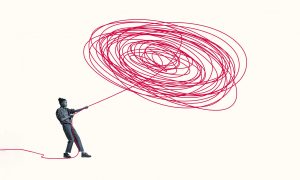Sometimes, a little extra pressure can help your team make better decisions and scale new heights.
Jonathan McBride knows something about how teams behave in a crisis. For five and a half years, he had a ringside seat in the Obama White House as an oil spill swamped the Gulf Coast and an earthquake devastated Haiti; as the H1N1 virus and Ebola threatened the U.S.; as the government shut down. Same at BlackRock, in the high-stakes sway of the financial markets, and, before that, as a co-founder of a small business where dramas unrolled every day, from cash-flow squeezes to personnel flare-ups to can-this-really-be-happening-now? tech failures.
In those tense, swirling moments, he’s seen plans botched, messages mishandled, and opportunities squandered. But he’s also watched as teams responded to a crisis in ways that were flat-out exhilarating: Communication quickened, hierarchies flattened, turnaround-time evaporated, talent blossomed, MacGyver-like fixes got the green light, mission-alignment reached 100 percent, and what truly matters suddenly truly mattered.
Which has led McBride, who served as the director of the White House office of presidential personnel and then as BlackRock’s global head of inclusion and diversity, to ask an against- the-grain question: What if a leader were to invite a “controlled crisis” upon her own organization–and then weaponize it? McBride believes that carefully injecting a little pulse-racing, brow-mopping crisis into the system will not only spark moments of epiphanic insight but may also lead to electrifying growth.
Skeptical? Consider the scientific evidence that a small but intense physiological crisis–like high-intensity interval training or intermittent fasting–can have outsize health benefits. As McBride sees it, a controlled crisis will do the same for your workplace. He’s now developing these counterintuitive ideas for an executive MBA course. Here, he gives Inc. readers a sneak preview.
Most leaders think they’re doing a crackerjack job when they’re avoiding a crisis. But you’re saying–
Over time, smooth is best. Fluidity is part of what makes you fast and responsive. But you can create grooves that become your default responses. Hierarchies and habits can develop and calcify, and that chokes off new ideas and slows the business.
But how is a crisis the antidote to that?
A crisis instantly disrupts your routines and explodes your habits. When a group of people suddenly face a crisis–a threat–and there’s time pressure, they tend to get very mobilized, organized, and focused, and look for new ideas in places they normally wouldn’t. It’s like intermittent fasting: The early stages, when you’re depleting your system, trigger a whole bunch of things that are restorative and cleansing. A little jolt to a team–and the metabolic shift that follows–increases energy, iteration, and focus.
When would you activate a controlled crisis?
When you believe you’re not getting the best out of a group–how they approach things, the level of creativity or focus. Are they stalled or stuck? Or perhaps you see a competitive opportunity and you need rapid iteration.
How big a crisis are we talking about unleashing?
Think of it as a dial, not a light switch. Part of the beauty of a controlled crisis is that you can calibrate it. Ideally, you’re not disrupting the whole organization; you’re targeting one group with a booster shot of adrenaline. You don’t need a five-alarm crisis to get the benefits.
Just like with fasting. You can’t go too long without food.
Right–you will die of starvation. Which is why managing in ongoing crisis mode is not a good idea. But take a look at the science. When you hold back inputs or resources, you actually induce the body to optimize itself. Same thing with high-intensity interval training. When you raise your heart rate to 80 percent of its maximum for a short period of time, good things happen.
So how would you start a controlled crisis?
The most obvious lever is time. If turnaround time is usually two weeks to prep a board presentation, now you say you need it in four days. That shared sense of risk combined with an aggressive timeline leads to a bucking of the system in beneficial ways. Or you can, without notice, cut away approval layers, which has the effect of increasing people’s sense of responsibility.
What does that look like?
People always tell me they wish the folks creating reports for them would act as if they were going straight to the CEO. You know what? Next time they hand one to you, tell them to walk it directly to the CEO’s office. They’ll return to their desk, think more, re-edit it. You’ve taken away the comfort of layers. That’s going to shake things up for them.”The beauty of a controlled crisis is that you can calibrate it. You’re targeting one group with a shot of adrenaline.”Jonathan McBride
What’s another way to initiate a crisis?
Remove a resource. Say the team usually outsources the creative to an agency. Well, now they have to solve the problem in-house–but maybe you let them bring in people from other departments to help. So we’re breaking the routine, activating their creativity, and also building new problem-solving pathways. Or you can take the leader out of the room and, all of a sudden, without as much clear structure, you’re going to get more ideas. People who play soccer will tell you that when one of your players gets a red card and your team is down a player, you’re suddenly more dangerous for a short period. Everyone gets a little more focused, works a little more closely together, overcommunicates, because they feel like it’s necessary. They’re doing all the virtuous things because they’ve lost a resource and there’s a risk. There’s fear and it’s shared.
Have you seen that in action?
Definitely. After George Floyd’s murder, I was asked to advise various boards and senior leadership teams about how their company might respond to a values-oriented crisis–an employee walkout, a staffer posting a memo about the company. At the offices of one extremely high-growth tech company, we called the entire senior management team together, presented the group with a few scenarios, and asked them to create the company’s response. The founders are generally pretty outspoken, but they intentionally stayed silent in this case–and that destabilized the room. What emerged was fascinating. The group wasn’t ready to address the issues, because they had a bigger problem: They didn’t agree on the company’s values. That was a huge realization that wouldn’t have arisen if the founders hadn’t neutralized themselves.
How would you use a controlled crisis to test a group’s plans or strategy?
I’d bring in a red team. Newsrooms sometimes use red teams to rapidly stress-test a bet-the-farm story. The people working on the story have to sit across from other journalists who try to poke holes in it. If they can’t resolve the questions, the story doesn’t move forward. This is a great way to hack groupthink and confirmation bias, which happens when your brain feeds you information that supports your hypothesis while filtering out some of the information that contradicts it.
OK, I’m going to red-team you now. The workplace can be stressful enough. Do the benefits of a controlled crisis outweigh the added anxiety?
Look, we need layers and processes for quality control, to limit downside risk. But over time, those layers also tend to limit the innovative ideas that are flowing upward, which can lead to a sclerotic organization as well as support unintentional bias. And sometimes those layers can even be the cause of the day-to-day stress you’re talking about. But when a crisis hijacks the system, suddenly people from across the organization become maniacally focused on the same thing. The number-one thing that gets people fired up at work is feeling that what they do is important. When the stakes are high and everybody is looking at the stakes the same way, as in a crisis, that’s naturally going to happen. Everybody suddenly understands the thing that needs to get done and done now–which isn’t always true in organizations. I’m talking about total alignment across the group.
Why is total alignment so important?
First, it’s just a great feeling. Normally, people pick things up and move them along when they can. One study showed that when someone is interrupted, it takes 23 minutes for them to get back to work, so there’s no momentum. But when everyone is focused on the same thing, people can iterate rapidly in real time. That focus not only lets the organization solve the problem at hand but–and this is almost more important–also allows everyone to see that total alignment is possible and to identify those things that might be blocking it.
How does a crisis lead to innovation?
New ideas get more love, because it’s often the old ideas that brought the crisis on. But the other benefit of a time-bound jolt to your system–where information is flying around in a less structured way, where people are looking everywhere for answers–is that you have a better chance of hearing from the people who are out of the usual lines of sight.
But in a crisis, when time is of the essence, don’t you want to hear from your most experienced people?
The truth is, the people in the organization closest to the customer are usually furthest from the decision-making authority. But they should have a voice in what you’re designing for that customer. In a crisis, you often see a CEO look down the rungs of the ladder. It’s that moment when a senior person hears a 24-year-old say something smart in a crisis meeting and walks her straight into the CEO’s office to explain the idea without first filtering it through seven people.
Right. That doesn’t happen on your average Tuesday.
But during a crisis, it does. You get it unfiltered. When I was at the White House, I learned that JFK created the Situation Room after the Bay of Pigs disaster, when he realized the information he was getting from the CIA and the Department of Defense was filtered through a long chain of consideration and scrubbing before it got to him. So he cleaned out a room and put officers from key agencies in there with a direct line from people in the field. That’s JFK cutting out layers, looking down the ladder.
Do you see a crisis as being a moment when ideas from diverse team members have a better chance to break through?
This is tricky. When we’re moving fast, we often default to our gut instincts–and the gut is where bias resides. We all have biases, like the bias toward the information we’ve heard most recently. But one of our biggest biases is for sameness: People who look like us and behave in a familiar way appear more predictable and so make us feel safer. We tend to trust their ideas more. In a crisis moment, somebody who’s talking in a different way, at a different pace, using slightly different words, and offering a different theory feels more risky. But when a challenge is coming out of a diverse, interconnected world, having more people thinking alike is actually way more risky because the world is not homogeneous.
How else do diversity and crisis intersect?
During a crisis, there’s a willingness to listen to people outside the normal hierarchy. Research has shown that women and people of color are more likely to become CEOs when a company is going through a crisis or period of struggle.
Is a crisis a good moment to spot emerging talent?
It’s a great time to earn a battlefield promotion. I was running a program that Obama had started for emerging leaders, and William McRaven, who led the Special Operations Command and oversaw the raid that killed bin Laden, stopped by the White House to talk to a group. He explained how one day you’re in the foxhole with your friends making fun of the lieutenant, and the next, someone comes to your tent and says, “The lieutenant had go back to the base. We’re promoting you.” So how did they find you? One way is that they look for who takes a leadership role in the middle of a crisis, who starts throwing out ideas even if they’re not the team leader. They also look for people who already have a followership.
Followership?
Meaning, when this person walks to the left, are people following her even though she’s low on the ladder? A crisis is a very good time to spot people like that.
What are some leadership traits to look for in a controlled crisis?
You want people who will speak truth to power. In a crisis, you really don’t want to be “yessed.” But the main thing to tune in to is people who are calm, who think clearly. At the White House, we used to tell a story about an astronaut who posed a question to a group of people: “Say you’re at the International Space Station and suddenly your oxygen goes out. You know you’ve got about 10 seconds before you start to lose consciousness. What do you do?” People started blurting out all these things they would do first–and he interrupts and says, “No. You think for eight seconds, and you make one move.” In a controlled crisis, you’re looking for the person who is lucid and clear when everybody else is going crazy, because when a crisis hits, you might only get one bite at the apple.
How to Have a Crisis
Reap the benefits of adrenaline without the agita.
Lay out the stakes. The crisis must be real, or at least mostly so. If it’s positioned as an exercise or something that doesn’t feel true (“An asteroid is coming!”), people won’t commit. Use an actual event–a big meeting, signals from a competitor–and tweak the timetable to boost the team’s adrenaline.
Give people control. Fend off fear and unconstructive behavior by clearly defining the goals, the tools that the team has at its disposal, and the endpoint. Give people something to do, even if it’s small, so that they feel they’re part of the collective effort. “People are scared of starving,” says McBride, “but not of fasting.” That’s because fasting is in their control.
Limit the scope. Your crisis should not be armageddon; if people fear for their jobs, they’ll be distracted, they’ll gossip. “You want to put a small amount of tension in the right area of the business at the right time while holding everything else calm,” McBride says.
Limit the time. Don’t underestimate how exhausting creativity and panic can be. One of the key ingredients built in to high-intensity interval training is rest.
Communicate early and often. In a real crisis, people get twitchy when there’s a lack of information. In a controlled crisis, you can anchor people’s minds by having your comms plan ready ahead of time. Telling people what you know and what you don’t know will keep them focused.
Encourage the new. Create space for new voices and processes. You want to bring different people into the room and give them the confidence to speak up; likewise, let folks experiment with hacking the system.
But don’t overvalue creativity. An ongoing idea-jam will take you only so far. “Somebody in the room needs to be good at coalescing a decision and figuring out how to operationalize the thing quickly,” says McBride.
Debrief the team. It’s important for everyone to understand what they went through and to talk about it together. Focus on the behaviors you want to stop and those you should encourage, which can help frame your conversation and crystallize the lessons.
The post How a Controlled Crisis Can Energize Your Company appeared first on Inc.
Original source: Inc.




